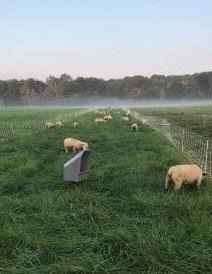By Melanie Barkley
Grazing management and genetic selection can help your flock minimize the impact of parasites.
Parasites continue to plague many sheep and goat producers throughout the grazing season. Internal parasites decrease growth rates and in high levels can even cause death. However, sheep and goat producers can follow several practices to minimize the impacts to their flock or herd. These practices center on grazing management, but can also include genetic selection principles.

Livestock pass internal parasite eggs in their manure. These eggs then hatch and go through several larval stages until they reach an infective stage. This can take as little as six days to go from egg to infective stage. Therefore, producers can use grazing rotations to stay ahead of this cycle. A key is to subdivide fields so that the animals have enough to eat for four to six days. Fields can be subdivided using temporary fencing such as poly-wire or electric net fence. These smaller areas allow sheep or goats to graze the forages present in the field more evenly. Rotate animals into a new field within six days in order to stay ahead of the parasite life cycle. In other words, the parasite larva reach the infective stage after the sheep or goats have moved out of that field.
Larva can survive for long periods, even as long as 120 days, when weather conditions are cool and moist. However, when the weather is hot and dry, those parasites can die very quickly. Therefore, the challenge comes when producers balance between these weather patterns to ensure that infective parasite larva are no longer present in the pastures. This can be much easier to write about than accomplish because the goal is to keep fields lush and growing, which creates a more ideal environment for the parasites. Harvesting fields for hay is one way to open up those areas to heat and sunlight in order to kill parasite larva. Another option is to have long rest periods so that the parasites die before the sheep return to that field to graze.
Parasites can also go into a hypobiotic or dormant state inside sheep or goats. Parasites can remain in this state until environmental conditions improve. Sheep and goat producers often see problems when this occurs during the summer. Animals graze pastures short during extended hot and dry weather conditions. Then, when weather conditions improve following a rain, a sudden parasite “bloom” occurs. Parasites that remained inside animals as well as parasites that remained in the egg stage develop very quickly to an infective state. This leads to very large numbers of infective parasites. Therefore, adequate rest periods of 65 days or more between grazings can be critical during the summer!
Multi-species grazing also contributes to breaking the parasite life cycle. While sheep and goats share many of the same parasites, cattle and horses do not. Cattle and horses grazed with sheep and goats help to break parasite life cycles because the sheep and goat parasites cannot survive in those other species. Sheep and goats can graze fields at the same time as cattle or horses, or they can graze in a leader-follower system. The leader-follower system allows one species to graze and then after an adequate rest period and forage regrowth, the other species grazes the field.
Another option to prevent parasite infections is to leave at least three inches of forage in the fields when animals move to the next field. Some producers will rotate sheep or goats at taller heights. Most parasite larva are found in the first two inches of forage growth, so the goal is to move the sheep and goats out of a field before they graze down to levels where parasite larva will be consumed.
A final option is to consider the genetics of the sheep and goats. Producers should keep records that identify when they treat animals for parasites. This information should include who was treated, date treated, and product used. Producers should also track withdrawal dates to ensure that no medication residues are present when sheep or goats go to market. Producers should cull animals that they consistently treat more often than most animals in the flock or herd. This allows producers to develop genetics that are more resistant to parasite infections. The parasites will still be present, but the animal’s immune system can better withstand the infection.
The National Sheep Improvement Program can take this selection practice a step further by identifying parasite resistant sheep and goats through Estimated Breeding Values. Producers develop these breeding values through fecal egg counts from each lamb or kid in the flock. Those individuals with higher resistance produce lower fecal egg counts. Producers enrolled in the program enter fecal egg count data along with other performance data and submit to LambPlan in Australia.